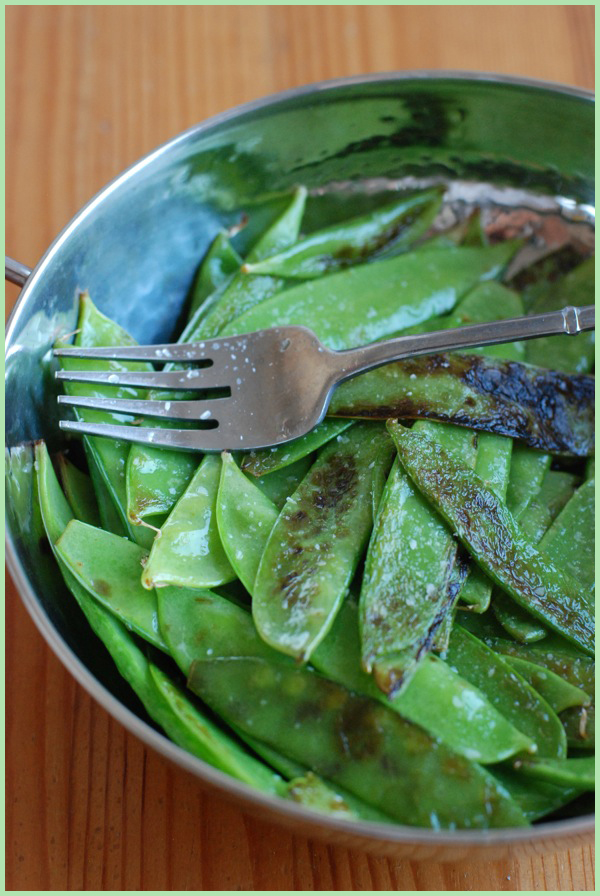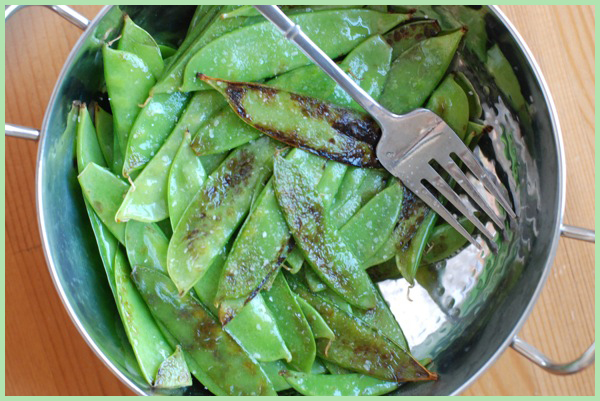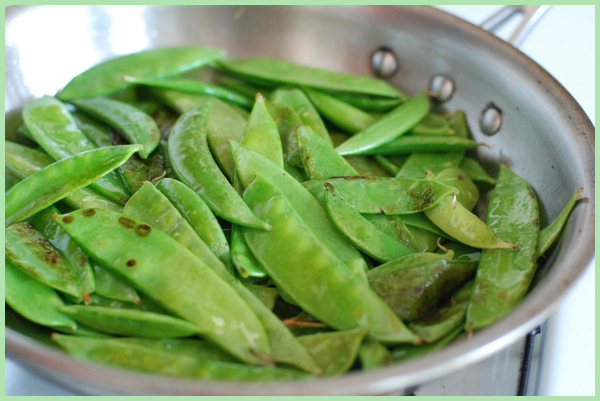 Readers, meet my new favorite side dish.
Readers, meet my new favorite side dish.
We spent the morning of our first full day in Santa Fe downtown, at a farmers' market adjacent to an artists' market (a lethal concoction as far as my wallet was concerned). At the tail end of our stroll through the farm stands, I caught a glimpse of an overall-clad gentelman manning a fry pan set over a camping stove. I headed over to see what he was cooking, and before I could see any of the wiry, bright green snowpeas bouncing around the frying pan, I hear the crackle-snap of their dip in the hot oil and knew the end result would be mighty tasty. I stuck around. Sure enough, after a few flips of the pan, the blistered snowpeas landed on top, giving their still-green comrades a turn over the heat. Once all the peas were glistening with oil and many were blackened in spots, the gentleman tossed a generous pinch of flaky salt over the vegetables, poured them onto a plate, and shouted for customers and neighboring farmers to get one while they're hot. I wasted no time popping one of the smoking-hot snowpeas into my mouth.
Their crunch was what caught me first: blackened where their bumpy surfaces had touched the scalding pan, much of the flesh managed to remain crisp, striking just the right balance of doneness. The snowpeas were vivid green, their juices gathering at the bottom of the plate and mixing with that lovely salt. I could've eaten the whole lot myself. Naturally, I bought a couple pounds of his bounty, determined to wow D's family with this surprising treat.
This isn't one of those stories that ends in failure. I'll spoil the punch-line right now: for an addictive appetizer or side, it just doesn't get more foolproof than this. You need only the most modest mis en place: a hot pan, a glug of oil, a couple pinches of salt, and the freshest, crispest snowpeas you can find. The dish practically makes itself. If you want to put them over the edge, squeeze some lemon over the peas just before serving.
If you're making these for a crowd and don't have a very large (15-inch) pan, make them in batches. You want these guys to really blister, and they won't if the pan is crowded. Let the snap-crackle of the peas be your guide: when the vegetables first hit the pan, they'll really sizzle (watch those forearms -- the oil will spatter). After a while, the sound will let up. If the next time you flip the peas, none have browned on the bottom, add a splash more oil: let the sizzling resume. I've made these twice, and each time, the peas have needed about four pan-flips, maybe a total of 7-8 minutes in the pan. Don't stress if yours seem done after 5 minutes or need a bit extra time -- they'll be done when they're done.
Last night, I served a dish of these snow peas as a side dish to complement seared tuna. But the first time I made them, I served them up right out of the frying pan, smoking hot, to a crowd of hungry bellies waiting on barbequed chicken. These were the perfect low-key appetizer, just the sort of thing you want to absentmindedly munch on while waiting for dinner to hit the table.
Simple Sauteed Snow Peas serves 6
2 lbs. snow peas, as fresh and crunchy as you can find 'em, rinsed and thoroughly dried olive oil 2 pinches salt wedge of lemon
Heat 2-3 tablespoons olive oil on medium-high in a large stainless steel pan, not a nonstick one. When the oil shimmers on the surface, add 1/3 of the snow peas (careful! oil will splatter). Leave the pan alone for a minute or two, and the peas on the bottom will begin to blister. After about 2 minutes, give the pan a big toss. Blistered peas should rise to the top, and less cooked ones should descend to the bottom of the pan, close to the heat. Again, let the pan be for about 2 minutes. Toss again, to redistribute peas. If peas haven't blistered, add a tablespoon more olive oil to the pan.
After about 7-8 minutes, peas should be cooked through but still crispy, and some should have darkened or blistered spots. At this point, sprinkle a pinch of salt over the peas, and transfer to a serving bowl or platter. Repeat this process twice more, cooking 1/3 of total peas each time. After all peas have been cooked and transfered to serving dish, squeeze wedge of lemon over peas, use large wide spoon to distribute lemon juice, and serve immediately. (Peas will also be delicious at room temperature, so if you're not serving as an appetizer to some hungry folks, don't sweat it; set them aside, and serve when everything else is ready.)

